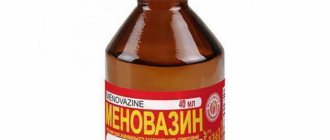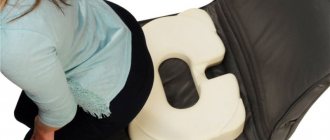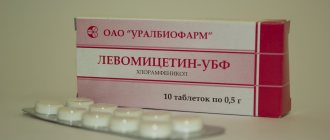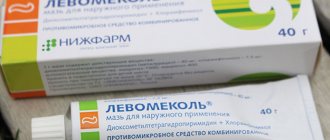The child's body is not yet fully formed, so the child is more often susceptible to diseases. In addition, he cannot help himself, because due to lack of experience he does not know how to do it, and here his parents must come to the rescue.
Diarrhea is a fairly common occurrence and has many causes. In treatment, one of the main points is to establish the factor that provoked the disorder, and then you can choose medications. Levomycetin helps against childhood diarrhea.
Compound
The active substance of Levomycetin in all its forms is chloramphenicol - a substance that belongs to the amphenicol .
Eye drops contain chloramphenicol at a concentration of 2.5 mg/ml.
Possible dosages of the active substance for capsules and tablets are 250 and 500 mg, for extended-release tablets - 650 mg (tablets have 2 layers - the outer contains 250, the inner contains 400 mg of chloramphenicol ).
An alcohol solution of Levomycetin is available in a concentration of 0.25; 1, 3 and 5%. Levomycetin ointment can have a concentration of 1 or 5%.
Drugs from different manufacturers have different compositions of auxiliary components.
All versions of the same product produced by pharmaceutical companies in post-Soviet countries differ slightly, since they use the same technology for producing chloramphenicol. Thus, Levomycetin DIA eye drops do not differ from the drops produced, for example, by the Belmedpreparaty company.
Description of the drug
Levomycetin for diarrhea for children
Levomycetin belongs to the amphenicol group of antibiotics. It is available in tablets with a dosage of 250 and 500 mg.
The drug is made on the basis of chloramphenicol, a synthetic antibiotic identical in composition to the natural substance produced by some types of bacteria.
Each Levomycetin tablet contains a number of additional components:
- calcium stearate;
- potato starch;
- medical low molecular weight polyvinylpyrrolidone.
Levomycetin is a broad-spectrum antibiotic and has a systemic effect on the body. The mechanism of its work is based on the suppression of the peptidyl transferase enzyme and disruption of protein synthesis in bacterial cells.
The activity of Levomycetin is manifested against gram-positive cocci:
- pneumococci;
- enterococci;
- streptococci;
- staphylococci.
Chloramphenicol also works successfully against a number of bacteria:
- salmonella;
- shigella;
- serrations;
- coli;
- Haemophilus influenzae;
- proteas;
- Klebsiella
Levomycetin: tablets
Levomycetin is effective against spirochetes, rickettsia, anaerobic bacteria, pathogens of inguinal lymphogranulomatosis, trachoma and psittacosis.
The drug successfully suppresses the activity of strains that are resistant to other groups of antibiotics - sulfonamides, streptomycin, penicillin. Bacterial resistance to chloramphenicol develops slowly.
Pharmacodynamics and pharmacokinetics
Is Levomycetin an antibiotic or not? An antibiotic of synthetic origin, which is identical to the product produced by the microorganisms Streptomyces venezuelae during their life.
Chloramphenicol is destructive to most gram (+) and gram (-) bacteria (including strains that are resistant to sulfonamides , streptomycin and penicillin ), spirochetes , rickettsia , and certain large viruses.
Shows low activity against Clostridium, Pseudomonas aeruginosa, acid-fast bacteria and protozoa.
The mechanism of action of the drug is associated with the ability of chloramphenicol to disrupt the synthesis of proteins of microorganisms. The substance blocks the polymerization of activated amino acid residues that are associated with m-RNA.
Resistance to chloramphenicol in microbes develops relatively slowly; cross-resistance to other chemotherapeutic drugs, as a rule, does not occur.
When applied topically, the required concentration is created in the aqueous humor, vitreous fibers, cornea and iris. The drug does not penetrate the lens.
Pharmacokinetic parameters when taking chloramphenicol orally:
- absorption - 90%;
- bioavailability - 80%;
- degree of binding to plasma proteins - 50-60% (in prematurely born
- term infants - 32%);
- Tmax - from 1 to 3 hours.
Therapeutic concentration in the bloodstream remains for 4-5 hours after oral administration. About a third of the dose taken is found in bile; the highest concentration of Levomycetin is created in the kidneys and liver.
The drug is able to cross the placental barrier, its serum concentration in the fetus can reach 30-80% of the serum concentration in the mother. Penetrates into milk.
Biotransformed mainly in the liver (90%). Under the influence of normal intestinal flora, it undergoes hydrolysis with the formation of inactive metabolites.
Elimination time is 24 hours. It is excreted mainly by the kidneys (90%). From 1 to 3% is excreted with the intestinal contents. T1/2 for an adult - from 1.5 to 3.5 hours, in children 1-16 years old - from 3 to 6.5 hours, in children 1-2 days after birth - 24 hours or more (with low weight longer body), on days 10-16 of life - 10 hours.
to hemodialysis .
Contraindications
The annotation states that contraindications to the use of Levomycetin are:
- hypersensitivity;
- depression of bone marrow hematopoiesis;
- acute intermittent (intermittent) porphyria;
- G6PD enzyme deficiency;
- renal/liver failure.
External therapy products are not applied to large granulating wound surfaces, as well as to skin affected by fungal infection , eczema or psoriasis .
For patients who have previously received cytotoxic drugs or undergone radiation therapy , pregnant women, young children (especially the first 4 weeks of life), the medicine is prescribed according to health reasons.
Indications and contraindications
Diarrhea in a child is a problem
The drug is prescribed for the treatment of infectious diseases caused by microorganisms sensitive to chloramphenicol. Indications for use of Levomycetin:
- paratyphoid;
- typhus and typhoid fever;
- meningitis;
- whooping cough;
- chlamydia;
- sepsis;
- tularemia;
- brucellosis;
- dysentery;
- brain abscess;
- trachoma;
- pneumonia;
- gonorrhea;
- actinomycosis.
Levomycetin is also prescribed for diarrhea in children, as many of the above diseases are symptomatically manifested by diarrhea. It is important to know the diagnosis accurately, since diarrhea can occur from food poisoning or even due to some psychological factors.
Side effects
Systemic side effects of Levomycetin:
- disorders of the digestive system - nausea, diarrhea , dyspepsia, vomiting, irritation of the pharynx and oral mucosa, dysbacteriosis;
- disorders of hemostasis and hematopoiesis - reticulocytopenia, leukemia and thrombocytopenia, agranulocytosis, hypohemoglobinemia, aplastic anemia ;
- disorders of the sensory organs and nervous system - depression, optic neuritis , mental and motor disorders, headache, disturbance of consciousness and/or taste, hallucinations (auditory or visual), delirium, decreased visual/hearing acuity;
- hypersensitivity reactions;
- addition of a fungal infection;
- dermatitis;
- cardiovascular collapse (usually in children of the first year of life).
When using eye drops, liniment and alcohol solution, local allergic reactions are possible.
Side effects of Levomycetin
The use of Lemomycetin for therapeutic purposes may cause the following side effects:
- Dyspeptic disorders.
- Changes in the circulatory system.
- Headache, hearing and vision impairment, decreased olfactory function, also frequent depression, neuritis and poor consciousness.
- Symptoms of an allergic reaction.
- Dermatitis.
- Collapse.
Eye drops rarely cause these symptoms. However, they can provoke a hypersensitivity clinic.
Instructions for use of Levomycetin
Levomycetin eye drops: instructions for use
Levomycetin eye drops (DIA, Akri, AKOS, Ferein) are applied into the conjunctival sac of each eye, one 3-4 times a day. The course of treatment usually lasts from 5 to 15 days.
When using the drug, you should tilt your head back, gently pull the lower eyelid towards the cheek so that a cavity is formed between the skin and the surface of the eye, and, without touching the eyelid and the surface of the eye with the tip of the dropper bottle, add 1 drop of the medicine into it.
After instillation, press the outer corner of the eye with a finger and do not blink for 30 seconds. If you cannot avoid blinking, you need to do this as carefully as possible so that the solution does not spill out of the eye.
For children during the neonatal period (the first 28 days after birth), the drug is used for health reasons.
For purulent otitis, the drug is injected into the ear 1-2 times a day. 2-3 drops each. If there is significant discharge from the ear canal that washes away the applied solution, Levomycetin can be used up to 4 times a day.
For bacterial rhinitis, your doctor may recommend using nasal drops.
Eye drops for stye
The use of chloramphenicol in combination with boric acid barley , which is included in the solution as an auxiliary component, helps prevent infection of the conjunctiva and the development of complications after opening the abscess, accelerates the ripening of barley , partially relieves redness and reduces the intensity of pain, reduces the time by 2-3 days recovery.
Treatment is carried out simultaneously for both the patient and the healthy eye. The product should be instilled 1-2 drops 2-6 times a day. In case of severe pain, Levomycetin can be instilled every hour.
Levomycetin tablets: instructions for use
Tablets and capsules are taken depending on the indications 3-4 times a day. A single dose of Levomycetin in tablets/capsules for an adult is 1-2 tablets. 250 mg. The highest dose is 4 tablets. 500 mg per day.
In particularly severe cases (for example, with peritonitis or typhoid fever ), the dose can be increased to 3 or 4 g/day.
Duration of use - no more than 10 days.
How to take Levomycetin for diarrhea?
Levomycetin is often used for diarrhea, which occurs due to food poisoning, as well as in cases where intestinal upset is a consequence of a bacterial infection.
Levomycetin tablets for diarrhea are taken before meals, one every 4-6 hours. The highest dose is 4 g/day. If after taking the first 500 mg tablet the disorder has stopped, you should not take the second one.
How to take Levomycetin for cystitis
For cystitis , tablets are usually used. In especially severe cases, the doctor may recommend injections of chloramphenicol (to prepare a solution, the powder is dissolved in water for injection or novocaine ) or a jet infusion of chloramphenicol on glucose into a vein.
Unless otherwise indicated, cystitis should be taken in a standard dosage every 3-4 hours.
Instructions for alcohol solution
The solution is intended for lubricating the affected skin surface or for use under an occlusive dressing.
The duration of treatment depends on the course of the pathological process, its severity and the effectiveness of therapeutic measures.
Cracked nipples should be treated with a 0.25% solution after each feeding. Treatment is continued for no more than 5 days.
Instructions for liniment
Liniment is applied to burned skin or wound surface after purulent exudate and dead tissue have been removed. Before treatment, the wound should also be washed with an antiseptic: 0.01% solution of miramistin , 0.05% solution of chlorhexidine digluconate , 3% solution of hydrogen peroxide or aqueous solution of furatsilin 0.02%.
The ointment is applied to the affected area in a thin layer and then covered with a sterile bandage. You can also soak a sterile piece of gauze with the drug and fill the wound with it or cover the burn surface.
When treating wounds, liniment is used 1 r./day, when treating burns - 1 r./day. or 2-3 rubles/week, depending on how abundantly the purulent exudate is released.
When treating bacterial skin infections, Levomycetin is applied to the affected areas (after they have been pre-treated) 1 or 2 times a day, in a thin layer and without a bandage, if possible, rubbing the medicine until completely absorbed into the affected skin and while capturing small areas of healthy skin around the pathological focus.
Dry wet areas with a gauze cloth before using the product.
In cases where Levomycetin is used under a bandage, it is applied 1 r./day.
Single dose - 250-750 mg, daily dose - 1-2 g of chloramphenicol . A course of treatment for a patient weighing 70 kg should require up to 3 kg of the drug.
Apply a thick layer of ointment to cracked nipples on a sterile napkin.
Levomycetin for acne
What is Levomycetin? Antibacterial drug. The ability to quickly suppress infectious and inflammatory processes allows the use of a remedy (tablets and alcohol solution) for acne.
For skin problems, it is usually recommended to use a 1% solution. The medicine is applied pointwise so as not to dry out the skin and not provoke the appearance of chloramphenicol- microbes, which in the future may cause the appearance of purulent acne .
The solution is used from the moment the pimple appears until it disappears. It is important to remember that the product is not intended for prophylactic use.
To treat acne and red, inflamed pimples, chloramphenicol is often used in combination with other medications.
The most popular are the following acne pills with Levomycetin:
- Aspirin , Levomycetin and calendula tincture. Acetylsalicylic acid (aspirin) and chloramphenicol take 4 tablets each and, crushing them into powder, pour 40 ml of calendula tincture.
- Boric acid , Levomycetin, salicylic acid and ethyl alcohol . To prepare the medicine, the ingredients are mixed in the following proportion: 5 ml of a two percent solution of salicylic acid , boric acid and alcohol - 50 ml each, Levomycetin - 5 g.
- Salicylic acid , streptocide , camphor alcohol , Levomycetin in the following proportion: 30 ml (2% solution)/10 tablets/80 ml/4 tablets.
Reviews allow us to conclude that these remedies are very effective if acne is isolated, but if the problem is larger, it is necessary to first eliminate its cause from the inside.
Overdose
Severe complications from hematopoiesis are usually associated with long-term use of doses exceeding 3 g/day. Symptoms of chronic intoxication: pale skin, hyperthermia, sore throat, hemorrhages and bleeding, fatigue or weakness.
Treatment with high doses of newborns can provoke the development of cardiovascular (“gray”) syndrome , the main symptoms of which are:
- change in skin color to bluish-gray;
- hypothermia;
- bloating;
- vomit;
- lack of nervous reactions;
- breathing rhythm disturbance;
- acidosis;
- circulatory collapse;
- cardiovascular failure;
- coma.
In 2 out of 5 cases the patient dies. The cause of death is the accumulation of the drug in the body due to the immaturity of liver enzymes and the direct toxic effect of floramphenicol on the myocardium .
Cardiovascular syndrome occurs when plasma concentrations of chloramphenicol exceed 50 mcg/ml.
Treatment involves gastric lavage, the use of saline laxatives, enterosorbents, and a cleansing enema. In severe cases, hemosorption and symptomatic therapy are indicated.
Increased doses of eye drops may cause temporary visual impairment. If the dose is exceeded, rinse your eyes with running water.
An overdose of external therapy may be accompanied by irritation of the skin and mucous membranes, as well as local hypersensitivity reactions.
Interaction
Interaction with topical application has not been described.
Chloramphenicol enhances the effect of hypoglycemic drugs (by increasing their plasma concentration and suppressing their metabolism in the liver), as well as the effect of drugs that inhibit bone marrow hematopoiesis .
The drug prevents the manifestation of the bactericidal effect of penicillin . Weakens the metabolism of warfarin , phenobarbital and phenytoin , increasing their concentration in the blood plasma and slowing their elimination.
In combination with clindamycin , erythromycin and lincomycin, the drugs mutually weaken each other's effects.
To prevent an increase in the inhibitory effect on hematopoiesis chloramphenicol should not be used together with sulfonamide drugs .
Levomycetin Renewal
- Hypersensitivity to chloramphenicol or other components of the drug;
- inhibition of bone marrow hematopoiesis;
- acute intermittent porphyria;
- deficiency of glucose-6-phosphate dehydrogenase;
- liver and/or kidney failure;
- pregnancy;
- breastfeeding period;
- children under 3 years of age and weighing less than 20 kg.
Side effect
Gastrointestinal disorders: dyspepsia, nausea, vomiting (the likelihood of development is reduced when taken 1 hour after meals), diarrhea, irritation of the oral mucosa and pharynx, dermatitis, dysbacteriosis (suppression of normal microflora).
Blood and lymphatic system disorders: reticulocytopenia, leukopenia, granulocytopenia, thrombocytopenia, erythrocytopenia, aplastic anemia, agranulocytosis.
Nervous system disorders: psychomotor disorders, depression, confusion, peripheral neuritis, visual and auditory hallucinations, headache.
Immune system disorders: skin rash, angioedema.
Visual disorders: optic neuritis, decreased visual acuity.
Hearing and labyrinthine disorders: hearing loss.
Infectious and parasitic diseases: secondary fungal infection.
Overdose
Symptoms: suppression of bone marrow hematopoiesis, gastrointestinal disorders, liver and kidney damage, neuropathy (including the optic nerve) and retinopathy.
Treatment: hemosorption, symptomatic therapy.
Carefully
Early childhood; previous treatment with cytotoxic drugs or radiation therapy.
Interaction with other drugs
It suppresses the enzyme system of cytochrome P450, therefore, when used simultaneously with phenobarbital, phenytoin, and indirect anticoagulants, a weakening of the metabolism of these drugs is observed, a slower elimination and an increase in their concentration in plasma.
Reduces the antibacterial effect of penicillins and cephalosporins.
When used simultaneously with erythromycin, clindamycin, lincomycin, a mutual weakening of the effect is observed due to the fact that chloramphenicol can displace these drugs from the bound state or prevent their binding to the 50S subunit of bacterial ribosomes.
Simultaneous administration with drugs that inhibit hematopoiesis (sulfonamides, cytostatics), affecting metabolism in the liver, with radiation therapy increases the risk of side effects.
When taking ethanol simultaneously, a disulfiram-like reaction may develop.
When prescribed with oral hypoglycemic drugs, their effect is enhanced (by suppressing metabolism in the liver and increasing their concentration in plasma).
Myelotoxic drugs enhance the hematotoxicity of the drug.
*for more details, see the instructions for medical use of the drug LP-004481
special instructions
The State Pharmacopoeia states that chloramphenicol is a white/white with a greenish-yellow tint, bitter-tasting and odorless crystalline powder. The substance is poorly soluble in water and easily dissolves in 95% alcohol. Almost insoluble in chloroform.
The gross formula of the substance is C₁₁H₁₂N₂O₅Cl₂.
Can I use drops in the nose and ear?
In practice, eye drops in the nose are used for bacterial rhinitis , in the ear - for purulent otitis media .
Despite the fact that using the drug for other purposes cannot be considered correct, such treatment does help in some cases.
Most often, ophthalmic forms for a runny nose are prescribed to children who do not yet know how to blow their nose on their own: a large amount of mucus with bacteria, if it gets into various sinuses, can provoke complications such as sinusitis or sinusitis .
Despite the fact that the use of Levomycetin drops in infants can dry out the mucous membrane and reduce the flow of snot, it has been proven that local use of antibiotics often does not effectively combat bacterial infection .
If we talk about the treatment regimen based on the “off-label prescription” principle (not for the intended purpose), then Levomycetin is instilled into the ear, 3-4 drops, and 1-2 drops into the nose. Treatment lasts from 5 to 10 days. The frequency of procedures is 1-2 per day.
Before applying the drug into the nose, it is necessary to first instill a vasoconstrictor. Before inserting into the ear, the external auditory canal should be cleared of pus.
Application in veterinary medicine
In veterinary practice, Levomycetin is used for colibacillosis , salmonellosis , leptospirosis , dyspepsia , colienteritis , coccidosis and pullorosis of chickens, infectious laryngotracheitis and mycoplasmosis of birds, urinary tract infections and bronchopneumonia .
The dose for farm animals, as well as for cats and dogs, is selected depending on the weight and severity of the disease.
How to give the drug to chickens? To avoid mass death of chickens from intestinal infection, they are given 1 tablet of Levomycetin along with food for 3-5 days, 2 times a day. This dosage is calculated for 15-20 chicks.
Analogs
Level 4 ATC code matches:
Colbiocin
Gentamicin
Tetracycline ointment
Fucithalmic
Tobrex
Preparations with the same active ingredient: Levomycetin Actitab , Levomycetin sodium succinate .
Analogues by mechanism of action:
- for Levomycetin tablets - Fluimucil ;
- for solution and ointment Levomycetin - aerosol Levovinisol ( generic), Bactroban , Baneocin , Gentamicin , Lincomycin , Syntomycin , Fucidin , Fusiderm , Neomycin .
Levomycetin eye drops can be replaced with the following drugs: Levomycetin-DIA , Levomycentin-AKOS , Levomycentin-Acri .
What is better - Levomycetin or Albucid?
Wikipedia states that Albucid ( sulfacetamide ) is an antimicrobial bacteriostatic agent from the sulfonamide .
The drug is used in ophthalmology for the treatment of bacterial keratitis , purulent ulcers of the cornea , blepharitis, conjunctivitis , chlamydial and gonorrheal diseases in adults, as well as blenorrhea in newborns.
Albucid , unlike Levomycetin, causes severe eye irritation.
pharmachologic effect
The drug has a pronounced antibacterial and some anti-inflammatory effect.
Pharmacological activity is manifested against most gram-negative and gram-positive microorganisms, also rickettsia, spirochetes and pathogenic bacteria that are resistant to streptomycin and sulfonamides.
The mechanism of action of Levomycetin is characterized by a violation of the genetic apparatus of microbes, which leads to the death of the latter.
The therapeutic concentration of the drug remains in the blood for up to 5 hours. The drug has high absorption and bioavailability. It is excreted mainly by the kidneys and a small part by the intestines.
Use of Levomycetin for children
Use of Levomycetin tablets in pediatrics
Tablet forms of the drug are used in pediatrics under constant monitoring of serum concentrations of chloramphenicol . Depending on age, the dose of Levomycetin tablets for children ranges from 25 to 100 mg/kg/day.
For newborn infants under 2 weeks of age (including premature infants), the formula for calculating the daily dose is as follows: 6.25 mg/kg per dose with a frequency of applications up to 4 times per day.
For infants over 14 days old, 12.5 mg/kg is prescribed per dose every 6 hours or 25 mg/kg every 12 hours.
For severe infections (for example, meningitis ), the dose is increased to 75-100 mg/kg/day.
How to take Levomycetin for diarrhea?
The drug is a fairly serious drug and therefore must be prescribed by a doctor. However, it is often given to children when it is necessary to relieve an intestinal disorder.
As a rule, the dose for children 3-8 years old is from 375 to 500 mg/day. (125 mg per 1 dose), for children 8-16 years old - 750-1000 mg (250 mg per 1 dose).
For diarrhea, a single use of the medicine is allowed. If the child’s condition does not improve, and symptoms persist 4-5 hours after taking the pill, you should consult a physician.
Levomycetin eye drops for children
Eye drops for newborns (in the first 4 weeks after birth) are used only for health reasons.
Levomycetin eye drops for infants are also used with caution. As a rule, 1 drop of antibiotic the conjunctival sac of each eye every 6-8 hours.
For barley , eye drops are not recommended for use in children under 10 years of age.
The use of external therapy in children
The solution is not intended for the treatment of children under 1 year of age; liniment is not used for the treatment of premature and newborn infants.
What is Levomycetin used for?
The antibiotic has a wide range of indications. Depending on the form produced, the medicine is used to treat various conditions.
Tablets are prescribed as a treatment for the following diseases:
- Infectious lesions of the biliary tract.
- Pathologies of the genitourinary system against the background of pathogenic microbes.
- Brain abscess.
- Peritonitis.
- Salmonellosis.
- Infection of the body with meningococcus.
- Typhoid fever.
Indications for the use of solution and ointment are:
- Bedsores of varying severity.
- Various wounds.
- Burns complicated by infections.
- Trophic ulcers.
- Bacterial skin infections.
- Nipple cracks in nursing women.
Eye drops are used as a treatment for:
- Blepharitis.
- Conjunctivitis.
- Keratitis.
Reviews of Levomycetin
Reviews found on the Internet about tablets and solution in most cases concern the use of the drug for acne.
When used externally - either in its pure form (if we are talking about a solution) or as part of a mash (for example, a mash containing Aspirin , Levomycetin and calendula tincture) - the product copes with acne within a couple of days.
There are no less good reviews about Levomycetin eye drops. Despite its low cost, the drug gives quick and in the vast majority of cases 100% results.
How much does Levomycetin cost?
The price of Levomycetin tablets for children (dosage 250 mg) is from 16 rubles, 500 mg tablets cost from 21 rubles. The price of Levomycetin eye drops 5 ml is 34-35 rubles, eye drops 10 ml cost an average of 45 rubles, and you can buy ointment for about the same amount. The price of Levomycetin in the form of an alcohol solution is from 20 rubles.
- Online pharmacies in RussiaRussia
- Online pharmacies in UkraineUkraine
- Online pharmacies in KazakhstanKazakhstan
ZdravCity
- Levomycetin Actitab tablets p.p.o.
500 mg 10 pcs JSC Alium 119 rub. order - Levomycetin solution, alcohol solution for outdoor use. approx. 3% fl. 25ml RenewalAO PFK Renewal
101 rub. order
- Levomycetin solution, alcohol solution for outdoor use. approx. 1% fl. 25ml RenewalAO PFK Renewal
99 RUR order
- Levomycetin renewal eye drops 0.25% 10mlAO PFK Renewal
101 rub. order
- Levomycetin renewal tab. p/o captivity. 0.5g 10pcsAO PFK Update
125 rub. order
Pharmacy Dialogue
- Levomycetin (alcohol solution 3% 25ml) Tverskaya FF
45 rub. order
- Levomycetin 0.25% dropper bottle 5 mlLekko JSC
15 rub. order
- Levomycetin actitab (tab.p.pl/vol. 500 mg No. 10) Obolenskoye pharmaceutical pred.
123 RUR order
- Levomycetin 0.25% bottle-dropper 10ml eye dropsLekko JSC
15 rub. order
- Levomycetin (alcohol solution 3% 25ml) Ivanovskaya farm. f-ka.
41 rub. order
show more
Pharmacy24
- Levomycetin 0.5 g No. 10 tablets PAT NEC "Borshchagivsky chemical-pharmaceutical plant", Kiev, Ukraine
30 UAH. order - Levomycetin 0.25% 10 ml eye drops TOV FZ BIOPHARMA, Ukraine / PrAT Biopharma, Ukraine
17 UAH order
- Levomycetin 0.25% 25 ml solution PRAT "Fitofarm", Ukraine
6 UAH order
- Levomycetin-DF 0.25% 10ml eye drops PRAT "Fitofarm", Ukraine
15 UAH order
- Levomycetin-KMP 250 mg No. 10 tablets PAT "Kievmedpreparat", Ukraine
21 UAH order
PaniPharmacy
- Levomycetin bottle Levomycetin sodium salt powder for injection 1g Ukraine, Kievmedpreparat OJSC
21 UAH order
- Levomycetin tablets Levomycetin tablets 0.5g No. 10 Ukraine, Kievmedpreparat OJSC
29 UAH order
- Levomycetin liquid Levomycetin h/c 0.25% 10ml Ukraine, Biopharma JSC
19 UAH order
- Levomycetin liquid Levomycetin solution alcohol. 0.25% 25ml Ukraine, Fitofarm ChAO
7 UAH order
- Levomycetin liquid Levomycetin h/c 0.25% ind. pack 10ml Ukraine, Fitofarm ChAO
18 UAH order
show more
Composition and release form
The drug is available from the pharmacy in several dosage forms:
- Eye drops 0.25%.
- Ointment 1% and 5%.
- A solution based on alcohol of different concentrations - 1%, 3%, 5%, 0.25%.
- Capsules and tablets of 500 mg and 250 mg, tablets of 650 mg with a prolonged therapeutic effect.
The active ingredient is chloramphenicol. Excipients:










